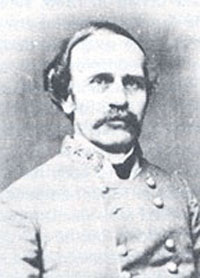
Bushrod Rust Johnson (1817-1880)
Bushrod Rust Johnson (October 7, 1817 - September 12, 1880) was a teacher, university chancellor, and Confederate general in the American Civil War.
Johnson was born in Norwich, Ohio, on October 7, 1817. He graduated from West Point and was appointed second lieutenant in the Third infantry. He served in the Seminole War, and was on frontier duty at Fort Leavenworth, Kansas, when he was promoted to first lieutenant in February 1844.
He participated in the Mexican War, and was engaged in the battles of Palo Alto, Resaca de la Palma and Monterey, and the siege of Vera Cruz. After the fall of that city he remained there on commissary duty until October.
He was forced to resign from the Army in 1847 and became a teacher after being accused of selling contraband goods. He was professor in the Western Military Institute of Kentucky from 1848 to 1851, when he became its superintendent. Four years later he became superintendent of the Military College of the University at Nashville, Tenn., a position he held until the outbreak of the Civil War. He was also at that time colonel of Tennessee militia. During his stay in Kentucky he had been lieutenant- colonel of militia.
He was appointed colonel of engineers in the provisional army of Tennessee on June 28, 1861. When the Tennessee troops were turned over to the Confederate States, he was assigned to the army acting in Tennessee and Kentucky under the command of Gen. Albert Sidney Johnston.
In 1861, he joined the Confederate Army and as a brigadier general fought at the Battle of Fort Donelson, Battle of Shiloh, Battle of Perryville, Battle of Stones River, Battle of Chickamauga, and Battle of Knoxville.
He commanded with great ability a brigade at Fort Donelson, having been commissioned brigadier-general January 24, 1862. Though captured on the fall of that important post, he was exchanged in time to bear a conspicuous part in the battle of Shiloh, where he was severely wounded April 6, 1862. On his recovery he went into the Kentucky campaign, and at the battle of Perryville, his and Cleburne's brigades, charging together, captured three batteries and many prisoners. General Johnson also led his brigade in Hardee's brilliant and successful charge in the battle of Murfreesboro. At Chickamauga, in the second day's battle, he was the first to detect and enter the gap in the Federal lines. Of this, Gen. D. H. Hill says: "With the coolness and judgment for which he was always distinguished, he took in the situation at a glance, and began a flank movement to the right. Longstreet adopted the plan of his lieutenant and made his other troops conform to Johnson's movement," thus sweeping away one wing of the Federal army and with it the commanding general himself. General Johnson also served under Longstreet in the unfortunate campaign into east Tennessee, commanding Buckner's division, brigades of Gracie, Johnson and Reynolds; shared in the disastrous assault on Fort Sanders (Knoxville), and fount the battle of Bean's Station.
Johnson, with his division, was near Petersburg, where he assisted in the defense against Butler's attack upon the Richmond & Petersburg railroad. His services were also eminent in the battle of Drewry's Bluff, where Beauregard "bottled up" Butler. A few days after this battle Johnson was commissioned Major-General (May 21, 1864). At the battle of the Crater, before Petersburg, he commanded the troops who repulsed the Federal assault. They captured three stands of colors and 130 prisoners that day. His men spent the remainder of the siege in the lines, ending up at the Battle of White Oak Road and Battle of Five Forks. At the evacuation of Richmond he commanded the division of Anderson's corps, comprising the brigades of Wallace, Moody, Ransom, and Wise, South Carolina, Alabama, North Carolina and Virginia troops. He was engaged in severe fighting preceding and during the retreat. His division was shattered at Battle of Sayler's Creek on April 6, 1865, and he was paroled at Appomattox Court House without a command.
Johnson returned to teaching to become a professor and chancellor of the University of Nashville. He then retired to a farm in Brighton, Illinois, where he died in 1880. He is buried in Old City Cemetery, Nashville, Tennessee.